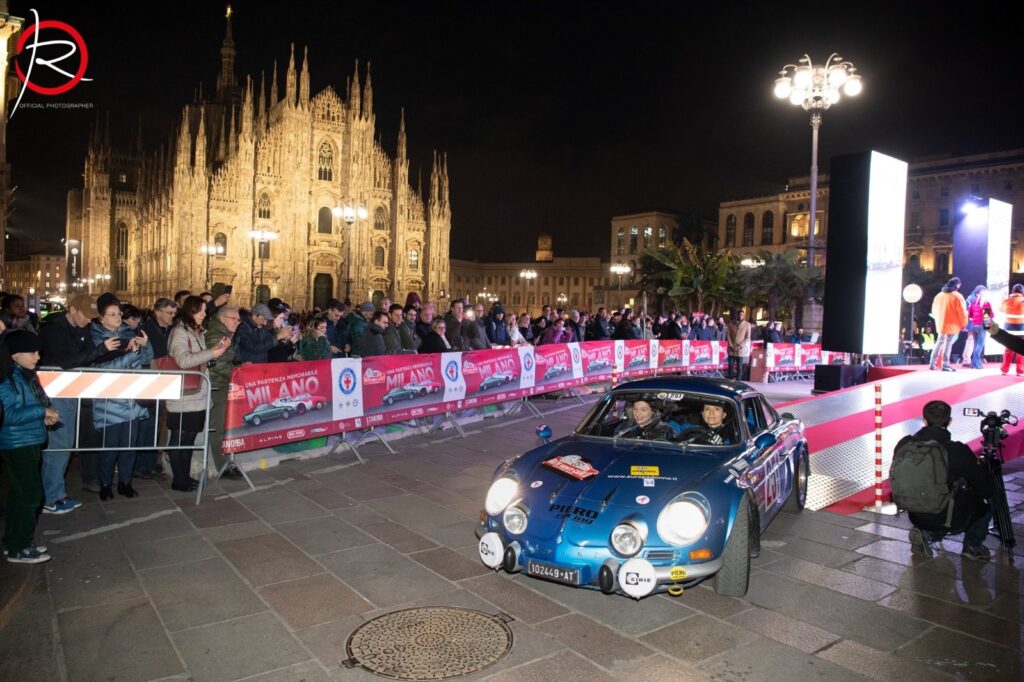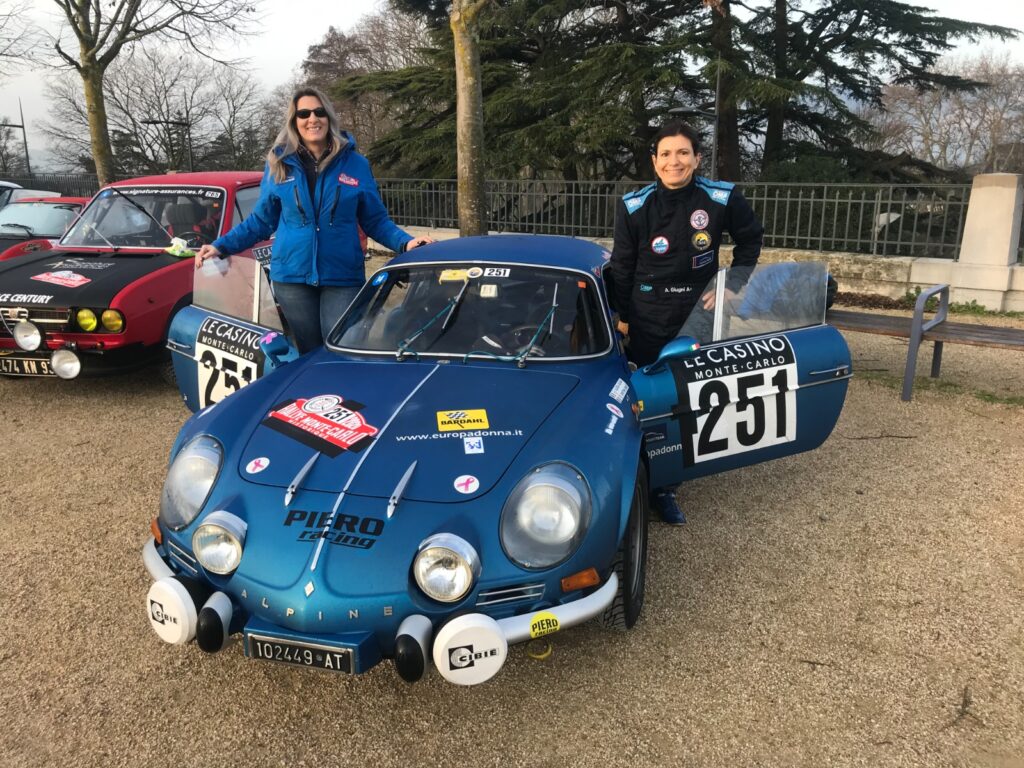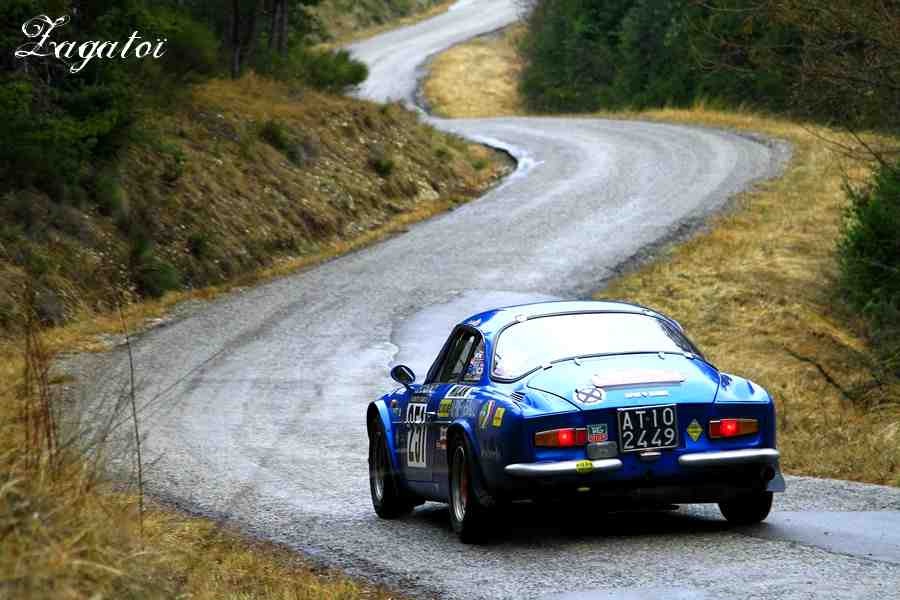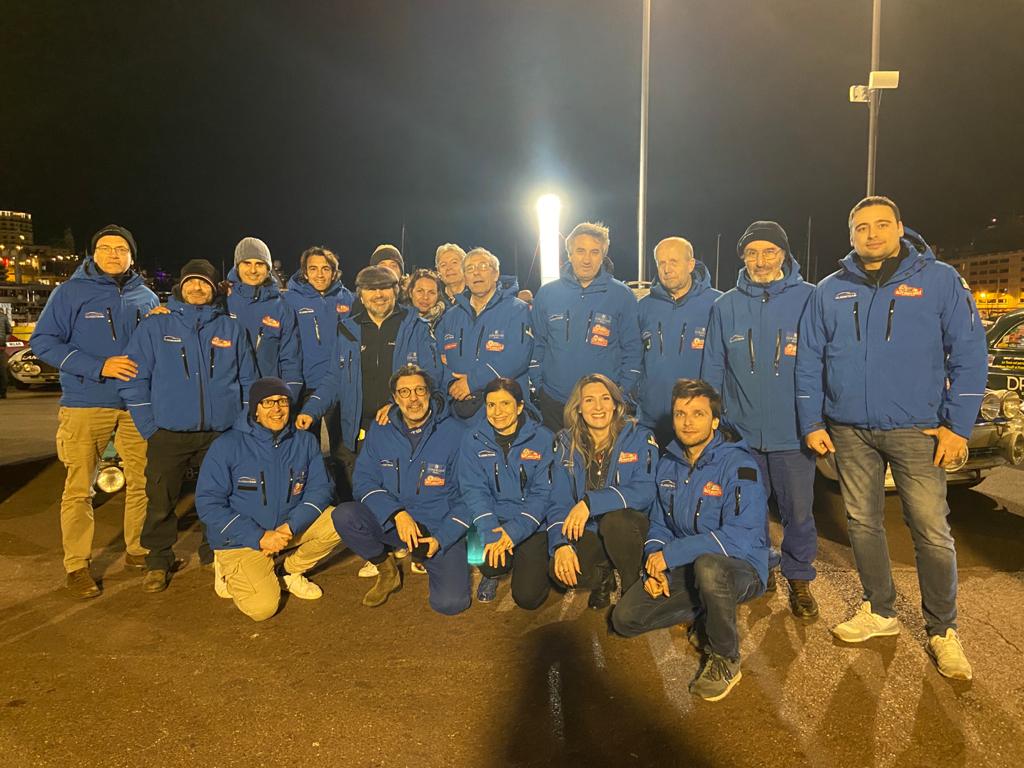
My Monte Carlo adventure began just a few days before the start of the Gran Premio Nuvolari 2019. My phone rang, and on the screen appeared the name of the vice president of my former racing team. I answered, expecting a conversation about the upcoming Gran Premio Nuvolari; however, he asked if I would like to navigate for Alexia Giugni in the Rallye Monte Carlo Historique 2020. Of course, I immediately said yes, unable to believe my luck. With Gaetana Angino (my driver for the classic regularity races in 2019), we had secured the national victory in the Italian Championship with a few races to spare. We were about to compete in the Gran Premio Nuvolari, and now this opportunity came along, one I never thought would materialize, and with one of my favorite cars: the 1971 blue Renault Alpine A110. I hit the jackpot!!!
I tried to stay rational; the Gran Premio Nuvolari was around the corner, and I didn’t want to miss the goal of winning the female category with Gaetana, who truly deserved it. So, maximum concentration was needed, and the goal was achieved: we raised the cup to the sky!!!
It was time to focus on the rally I had heard so much about but knew so little about since it was a specialty unfamiliar to me: THE AVERAGE SPEED. And so, I began studying the instrument that would support me in this specialty. Alexia and I decided to participate in a race to experience firsthand how such a race unfolded. One week before the Big Race scheduled for November 8, 2019, we started the reconnaissance with a modern car. I was desperate; I felt terrible during the reconnaissance, which lasted only one day, knowing full well that for Monte Carlo, it would last at least 4 days. I didn’t know what to do, and I confessed my discomfort to Alexia only much later, and especially after finding a solution that allowed me to read and write without feeling like my stomach was an enemy to be slain (I didn’t want to miss this opportunity for any reason in the world, and besides, it’s sacrilege to know that a navigator suffers from motion sickness, what a shame it would be after all the kind words Marco Gandino had said about me?).
The solution came, and the reconnaissance went very well; I didn’t even feel a hint of discomfort.
And now, the fun began: creating, elaborating, and adjusting the Road book with all the information because what the ACM (Automobile Club de Monaco) calls a road book is nothing more than a list of roads and kilometers that are difficult to read during the race.
The days were marked by everyday life, with the fixed thought of having to watch the videos that Maurizio Aiolfi had shot during his reconnaissance, translating the numbers taken during our reconnaissance, and all this data went into increasing the road book. I spent entire weeks working until 2 in the morning, terrified of not being able to finish in time to print everything. Instead, on the Monday before the start, I managed to take the files to the copy shop and have them printed… we were leaving on Friday!
Thursday, January 30th, was the fateful day; I left the office and began my journey to Milan, where on Friday, January 31st, at 18:40, I would begin this splendid adventure!
And so, we set off, passing through Piazza Duomo, where the starting ramp was set up—a unique emotion, with crowds eagerly awaiting the passage of the cars, which, like a caravan spaced one minute apart, were preparing to face this marathon called Rallye Monte Carlo Historique.

The first checkpoint awaits us in Sestriere; our arrival is ahead of schedule, and the camper provided by the team replenishes us with food and coffee, allowing us to relax for a moment and even catch a wink of sleep. The marshals arrive, and after a quick check-in, we’re off again. Another checkpoint in Chambery, and we head towards Bourgoin Jallieu, where the first time control awaits us.
Now it’s February 1st, it’s 8:53 after 14 hours and 13 minutes of almost continuous driving, and we’re heading towards Buis les Baronie, another time control marked for 13:33. Here, we have 30 minutes available for the installation of the instrument that will be both a help (the official time displayed) and a nightmare (continuous monitoring of adherence to the route and speed limits 24/7).
We set off again at 14:03 to face the first two special stages… I expected to be exhausted, tired, and nervous at this point, but it’s not the case—I’m calm and fresh, ready to tackle the first two special stages of 43 km and then 15 km.
The last two time controls, and at 19:28, we arrive at the end of the first day in Valence, after 25 hours of driving and 1,050 km covered, ranking 38th overall. We’re thrilled!!!
Day 2 – February 2nd, we restart at 10:20 am—four special stages totaling 154.675 km for a total of 382 km covered, and after 10 hours and 30 minutes, we return to Valance at 8:50 pm, with the bitterness of the first two stages going terribly without understanding the reason. We slide to 100th place. Alexia is furious; she refuses to lose in this way and doesn’t even want to take a bite to eat. She returns to the hotel to devise a strategy for the following day to try to claw back some positions.

Day 3 – February 3rd, we restart at 10:06 am—four special stages totaling 86.207 km for a total of 479 km covered, and after 11 hours and 20 minutes, we return to Valance at 9:26 pm, now determined to simply enjoy ourselves on the special stages. Despite this mindset, we still manage to claw back 20 positions and climb to 80th place. But it’s not over; adrenaline is always lurking, reshuffling the deck. There’s no time to relax. Upon arriving at the hotel, we discover that the ACM has modified the route due to a landslide, also altering the start of a stage, throwing off all the references we had taken during the reconnaissance… there’s a new road book to study that has been provided to us… PANIC! But Alexia is experienced; she’s now in her 10th edition and armed with a laptop and Google Maps, we study the entire new route, and off we go, ready for whatever comes our way.

Day 4 – February 4th, we restart at 8:59 am—we leave Valance and head towards the final stage, finally reaching the Principality of Monaco, Monte Carlo. But first, we face another 3 special stages totaling 56.500 km for a total of 442 km, and after 9 hours and 15 minutes, we arrive at the time control in La Turbie, at the gates of the City of Monte Carlo. But there are still the last 10 km and 35 minutes to cover… we encounter a traffic light that seems purposely designed to test my nerves and my heart. Minutes pass, the time control approaches, and we remain stuck in line, waiting… I want to scream at Alexia to overtake them all in line, skip the traffic light, and fly towards the time control, but I say nothing. I remember that we have the Tripy in the car, the infernal device that monitors our every move; the specter of being assigned 10,000 penalties doesn’t sit well with me. Besides, we’re on the doorstep of the principality, which has more cameras than inhabitants, and the gendarmerie is omnipresent. So, I remain still and mentally count the minutes and seconds that will determine the penalty for our lateness. In all the years I’ve been racing, I’ve never missed a time control. Is it possible that I’m about to experience the biggest setback for a navigator at the Rallye Monte Carlo??? PERISH THE THOUGHT!!! Alexia reads my mind, and finally, we pass the cursed traffic light. I navigate her, we overtake two competitors in the roundabout on two wheels, we race through a tunnel, brushing past a bus, and the little Alpine comes out on top. Right turn, and off we go, racing towards the orange-coated marshals. Our minute has already started, and with the horn blaring, we leap onto the arrival platform, and I eject myself out of the cockpit, catapulting myself onto the commissioners’ table 10 seconds before our scheduled time… WE DID IT!!! We made the time control on time, but the adrenaline and tension make my hands and legs tremble… but there’s no time for distractions. It’s 6:49 pm; we’re 71st overall, and we only have 3 hours to grab a bite to eat, take a shower, and review the videos to tackle the last two special stages, which seem to be the most fun but also the most challenging, including the Col de Turini.
At 10:43 pm, we restart, the last 150 km and the last two special stages of 70 km. Col de Braus and Col de Turini, a unique thrill, an infinity of hairpin turns. I discard the references taken during reconnaissance to call the curves and hairpin turns as I see them: right turn, left turn, double right, triple left, straight… we climb the switchbacks where, despite the late hour, many people are camped out with bonfires, cheering us on at every turn, and the strategically positioned car lights provide the best visibility of the turns. The emotion is indescribable, and Alexia’s driving is that of a true rally driver, sweeping through the curves.
The end has come; we finish the last special stage. I would like to go back and do it again… but it’s not possible. It’s the dead of night, and we have the last time control at 4:08 am… We arrive at the end of this adventure, the platform at the port of Monte Carlo welcomes us for the last time, and the crowd applauds as each competitor arrives. Our teammates, mechanical support, and moral support await us with a bottle to celebrate… my heart and head are filled with emotions unlike any other, indescribable, wonderful. They cannot be explained, only lived, and I have experienced them to the fullest with a highly respectable driver and a team of special people behind us who have taken care of every detail.

We conclude our adventure in 37th place overall, second among Italian crews, second among female crews, and the first crew from our team.
Total distance covered: 2,500 km
Special stage distance: 430 km
Total driving time: 61 hours and 55 minutes
Cristina Biagi x Promotor Classic Magazine


